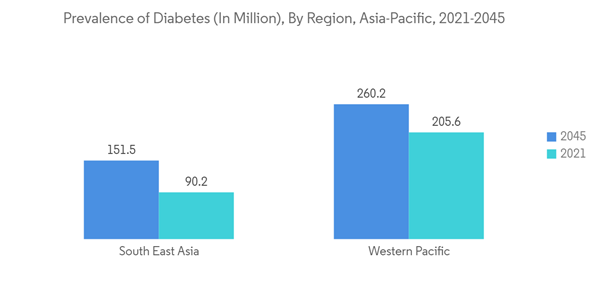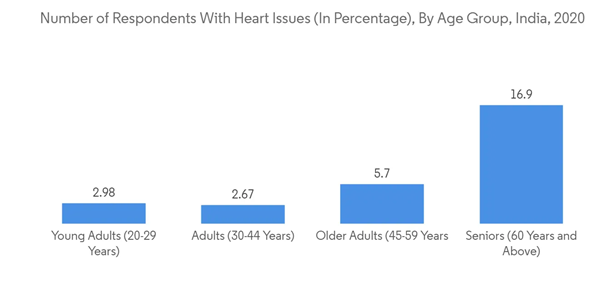The Asia-Pacific Wearable Medical Devices Market size is estimated at USD 10.60 billion in 2024, and is expected to reach USD 22.27 billion by 2029, growing at a CAGR of 16.01% during the forecast period (2024-2029).
COVID-19 has expedited the technological transition in the medical device industry that is currently underway. The outbreak has resulted in an unprecedented focus on public health, which has led to an increase in preventive and long-term patient care aids and equipment at the consumer level. According to the study titled "The Rise of Wearable Devices during the COVID-19 Pandemic: A Systematic Review" published in the Journal of Sensors in August 2021, remote monitoring of COVID-19 symptoms is in high demand in healthcare. Companies manufactured a variety of IoT-based devices and wearables last year, with promising findings in terms of high accuracy in identifying patients in the prodromal phase and monitoring symptoms such as breathing rate, heart rate, temperature, and so on. Such studies demonstrate the positive impact of COVID-19 on market growth.
Currently, remote monitoring of COVID-19 symptoms is in high demand in healthcare across the region, and several companies are engaged in developing and manufacturing devices that aid in no-contact tracking of patient symptoms. For instance, in March 2021, EOFlow, a wearable drug delivery solution provider, launched a new smartphone application for integration with wearable insulin delivery devices, which has also been allowed to be sold in South Korea.
Moreover, increasing technological breakthroughs and innovations, rising per-capita wealth in developing countries, and the simplicity of use and interpretation of medical devices are all driving the regional industry forward. For instance, in December 2021, with the release of the Huawei Watch D in China, Huawei added a smartwatch to its product portfolio. It's the company's first wristwatch with a blood pressure monitor on the wrist. The Chinese Drug Administration has designated the smartwatch as a Class II medical device.
Thus, owing to the abovementioned factors, the market is expected to show growth over the forecast period. However, the high cost of the products is expected to impede the growth of the market.
The domination of this segment is due to a shift in adult preferences toward sports and leisure activities, as well as the introduction of smart and advanced wearable gadgets that track activity. Fitbit Inc., for example, released Fitbit Charge 4, its most advanced health and activity tracker, in March 2020. This new device has the most up-to-date sensors and functions, as well as built-in GPS, Spotify, and connect and control tools.
Additionally, in January 2021, OnePlus launched its first fitness band in India. The fitness band sports a 1.1-inch AMOLED display, which is almost the standard size display for a fitness band these days.
Thus, owing to the abovementioned factors, the market segment is expected to show growth over the forecast period.
Furthermore, the increase in cases of chronic conditions, such as obesity, heart problems, breathing problems, and many more such diseases, helps to drive the Asia-Pacific market. For instance, according to the GOQii India Fit Report 2021 released in February 2021, according to the findings of a large-scale survey done across India, the majority of those suffering from cardiac ailments in 2020 will be 60 years old or older. Teenagers accounted for roughly 6% of those with cardiac problems, while young adults accounted for only 3% of those with the ailment that year. Therefore, India's wearable medical device market appears to have a promising future on account of increased awareness of the value of exercise and a healthy lifestyle, rising chronic disease rates, and technological advancements as the main drivers of growth.
Thus, owing to the abovementioned factors, the studied market in India is expected to show growth over the forecast period.
This product will be delivered within 2 business days.
COVID-19 has expedited the technological transition in the medical device industry that is currently underway. The outbreak has resulted in an unprecedented focus on public health, which has led to an increase in preventive and long-term patient care aids and equipment at the consumer level. According to the study titled "The Rise of Wearable Devices during the COVID-19 Pandemic: A Systematic Review" published in the Journal of Sensors in August 2021, remote monitoring of COVID-19 symptoms is in high demand in healthcare. Companies manufactured a variety of IoT-based devices and wearables last year, with promising findings in terms of high accuracy in identifying patients in the prodromal phase and monitoring symptoms such as breathing rate, heart rate, temperature, and so on. Such studies demonstrate the positive impact of COVID-19 on market growth.
Currently, remote monitoring of COVID-19 symptoms is in high demand in healthcare across the region, and several companies are engaged in developing and manufacturing devices that aid in no-contact tracking of patient symptoms. For instance, in March 2021, EOFlow, a wearable drug delivery solution provider, launched a new smartphone application for integration with wearable insulin delivery devices, which has also been allowed to be sold in South Korea.
Moreover, increasing technological breakthroughs and innovations, rising per-capita wealth in developing countries, and the simplicity of use and interpretation of medical devices are all driving the regional industry forward. For instance, in December 2021, with the release of the Huawei Watch D in China, Huawei added a smartwatch to its product portfolio. It's the company's first wristwatch with a blood pressure monitor on the wrist. The Chinese Drug Administration has designated the smartwatch as a Class II medical device.
Thus, owing to the abovementioned factors, the market is expected to show growth over the forecast period. However, the high cost of the products is expected to impede the growth of the market.
Asia-Pacific Wearable Medical Devices Market Trends
Sports and Fitness Segment is Estimated to have the Significant Share in the Market
Sports and fitness devices are the most well-known and widely used healthcare wearables for monitoring vital metrics. Athletes utilize wearable equipment to monitor their heart rate, blood pressure, and other vital signs. Individuals in the Asia Pacific have begun to focus on their well-being as a result of the increased prevalence of lifestyle disorders such as obesity, stroke, type 2 diabetes, heart disease, and atherosclerosis. As a result, the number of gyms and fitness centers is increasing, which is boosting sales of wearable medical devices in the region. For instance, according to the International Health, Racquet & Sportsclub Association (IHRSA) Media Report 2021, China has the most health and fitness clubs in the region in 2020, with 27,000 clubs. In 2020, Australia had 3,715 health and fitness clubs.The domination of this segment is due to a shift in adult preferences toward sports and leisure activities, as well as the introduction of smart and advanced wearable gadgets that track activity. Fitbit Inc., for example, released Fitbit Charge 4, its most advanced health and activity tracker, in March 2020. This new device has the most up-to-date sensors and functions, as well as built-in GPS, Spotify, and connect and control tools.
Additionally, in January 2021, OnePlus launched its first fitness band in India. The fitness band sports a 1.1-inch AMOLED display, which is almost the standard size display for a fitness band these days.
Thus, owing to the abovementioned factors, the market segment is expected to show growth over the forecast period.
India is Expected to attain the Major Market Share in the Market
In India, a large percentage of the population has lifestyle-related diseases such as diabetes and obesity, which have increased the risk of cancer. This has raised concern levels in societies about the early diagnosis of diseases, which increases the demand for wearable devices. For instance, as per the International Diabetes Federation (IDF) Report 2021, in terms of the number of people affected by diabetes mellitus, India is second only to China. In India, the prevalence of diabetes among people aged 20 to 79 years is 9.6%. This equates to 74.19 million diabetes cases, with the number anticipated to rise to 92.9 million by 2030. There are about 53.1% of those who have never been diagnosed with diabetes. Currently, India accounts for one out of every six adults in the world who has diabetes, as per the same source.Furthermore, the increase in cases of chronic conditions, such as obesity, heart problems, breathing problems, and many more such diseases, helps to drive the Asia-Pacific market. For instance, according to the GOQii India Fit Report 2021 released in February 2021, according to the findings of a large-scale survey done across India, the majority of those suffering from cardiac ailments in 2020 will be 60 years old or older. Teenagers accounted for roughly 6% of those with cardiac problems, while young adults accounted for only 3% of those with the ailment that year. Therefore, India's wearable medical device market appears to have a promising future on account of increased awareness of the value of exercise and a healthy lifestyle, rising chronic disease rates, and technological advancements as the main drivers of growth.
Thus, owing to the abovementioned factors, the studied market in India is expected to show growth over the forecast period.
Asia-Pacific Wearable Medical Devices Industry Overview
The Asia-Pacific wearable medical devices market is fragmented and competitive. The key growth strategies adopted by key players include strategic acquisitions, collaborations, and partnerships that may help them expand their geographical presence and strengthen their business positions. Some of the companies currently dominating the market are Garmin Ltd, Apple Inc., Fitbit Inc., Lifesense, Sotera Wireless, Philips (Biotelemtry, Inc.), Samsung, Vital Connect, GOQii, and Abbott Laboratories.Additional Benefits:
- The market estimate (ME) sheet in Excel format
- 3 months of analyst support
This product will be delivered within 2 business days.
Table of Contents
1 INTRODUCTION
4 MARKET DYNAMICS
5 MARKET SEGMENTATION (Market Size by Value - USD million)
6 COMPETITIVE LANDSCAPE
Companies Mentioned (Partial List)
A selection of companies mentioned in this report includes, but is not limited to:
- Garmin Ltd
- Apple Inc.
- Fitbit Inc.
- Lifesense
- Sotera Wireless
- Philips (Biotelemetry, Inc.)
- Samsung
- Vital Connect
- Abbott Laboratories
- GOQii
Methodology

LOADING...










